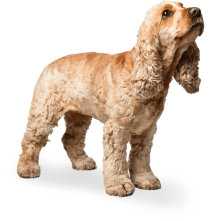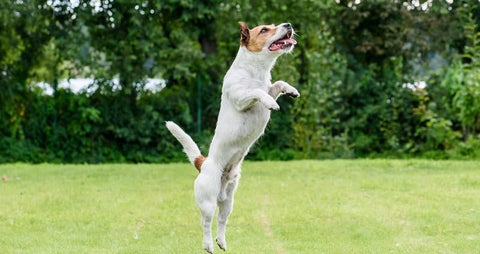

Understanding dog joints: Anatomy and issues
Understanding normal joint anatomy in dogs, as well as what could go wrong, is crucial to support your pet’s health and well-being. With both lameness and osteoarthritis featuring in the UK's top 10 most commonly diagnosed disorders, we’re shining the spotlight on dog joints. As well as dog anatomy, read on to discover warning signs like stiffness, clicking dog joints, and limping, as well as what to do if you think your dog is suffering from joint pain.
Anatomy of dog joints
A dog’s skeleton is made up of many joints which allow movement. Within these joints is cartilage, a type of cushioning shock absorber, and joint fluid. These help dogs move comfortably and smoothly, as well as stop bone rubbing against bone.

Dog’s shoulder joint (glenohumeral joint)
Dogs have a similar shoulder (glenohumeral) joint to humans. It is a ball and socket which allows movement in all directions. This joint is supported by muscles including the deltoid, supraspinatus and infraspinatus. Shoulder injuries include biceps tendon luxation, shoulder dislocation and traumatic cartilage injury.
Dog elbow joint (humeroradial and humeroulnar joint)
The dog elbow joint is a hinge joint, meaning it only allows restricted movement – extension and flexion. It is sometimes known as the humeroradial and humeroulnar joint, because there are three bones all meeting here – the radius, ulna and humerus. Elbow dysplasia is a common issue, where there is abnormal development of the joint and the bones don’t fit together properly.
Dog’s wrist joint (the carpus)
A dog’s wrist (carpus) is made up of 7 short bones arranged in two rows between the forearm (radius-ulna) and the metacarpals. Ligaments support these bones and help the carpus to hold a normal angle when a dog is standing or exercising. A common issue is carpal hyperextension which can be caused by trauma, poor nutrition, developmental issues and age-related changes.
Dog’s hip joint (os coxae)
The dog hip joint (os coxae) is a ball and socket, with the head of the thigh bone (femur) fitting smoothly into the pelvis. Some important muscles and tendons support this joint, as well as major blood vessels and nerves that run through this area. Hip dysplasia in dogs is an extremely common developmental abnormality in this joint, but hip dislocation is another issue that can affect this joint.
Dog’s knee joint (stifle joint)
A dog’s knee (stifle) joint is very similar to ours. Three bones meet here, the femur (thigh bone), the patella (kneecap) and the tibia (shin bone). Two C-shaped cartilage shock absorbers known as the medial and lateral menisci, help with stability as do supporting ligaments like the cruciate and collateral ligaments. Common knee joint issues include luxating patella and cruciate ligament disease.
Dog’s ankle joint (hock joint)
The ankle (hock) joint in dogs is complicated and made up of three different joints, the tibiotarsal, intertarsal and tarsometatarsal joints. The hock is supported by a variety of ligaments to ensure stability. Fractures and ligament damage commonly affect this joint.
Dog’s spine
A dog’s spine is made up of short bones called vertebrae which are joined together by ligaments and muscles. Between the vertebrae are intervertebral discs which act as a cushion between bones and aid flexibility. The spinal cord helps to protect the nerves in the spinal cord. Common issues affecting the spine include intervertebral disc disease (IVDD), cervical spondylomyleopathy (Wobbler's Syndrome) and traumatic injuries.
Note – any of the joints listed can suffer from osteoarthritis, either due to wear and tear or because of previous injury

Types and causes of joint pain in dogs
Multiple issues can cause joint pain in dogs which is why seeking a diagnosis from a vet is so important.
Causes of joint pain include –
- Traumatic injury
- Infection
- Autoimmune conditions
- Developmental disorders
- Degenerative joint disease
- Cancer
The two most often seen are developmental and degenerative issues.
Developmental disorders are often inherited and occur when the joints don’t form properly as a dog grows and matures. Common examples include hip and elbow dysplasia.
Degenerative joint disease is more common in older dogs but can affect dogs of any age. Over time the cartilage inside the joints becomes worn away, leading to pain, inflammation, issues with joint fluid and bone changes. This is called osteoarthritis, and it can be secondary to trauma, developmental abnormalities and infection, but we also see it with general wear and tear especially in large or overweight dogs. This is often what most people are referring to when they talk about arthritis in dogs.
Types and causes of joint pain in puppies
Joint pain in puppies can be due to developmental abnormalities like hip and elbow dysplasia, but we often see trauma in young dogs too. A vet will help to determine the issue and suggest treatment, including what age to give your dog joint supplements.
What are the symptoms of joint pain?
Symptoms of joint pain may include one or more of the following –
- Limping which could be continuous or intermittent
- Stiffness, especially after sleeping
- Clicking or creaking joints
- Reluctance to exercise or slowing down on walks
- Changes in temperament such as sleeping more or becoming more irritable
- Pain, crying out
- Difficulty jumping up
- Fever might be seen in infectious disease or autoimmune joint issues
How is dog joint pain treated?
How your dog’s joint pain is treated will depend on the underlying cause.
Common treatments include –
- Pain relief including non-steroidal anti-inflammatory drugs and monoclonal antibodies
- Hydrotherapy for dogs or physiotherapy
- Joint supplements
- Weight loss
- Adapting the environment e.g. providing a padded bed and non-slip flooring.
- Surgery
- Alternative therapies like acupuncture
Your vet will be able to advise you further on what might be most suitable for your pet.
The Takeaway
Dog joint anatomy is complicated which is why things can go wrong. If you suspect your dog has sore joints, then you must speak to a vet for advice. We know it can be a worrying time, but a proper diagnosis will help you to manage the problem more effectively. Early intervention leads to better outcomes, so call your vet sooner rather than later!
If you enjoyed this piece, why not discover YuMOVE's Health Guides for expert advice on pet care.




